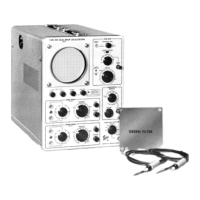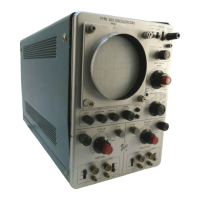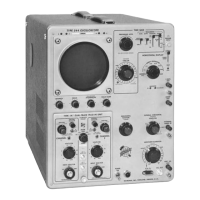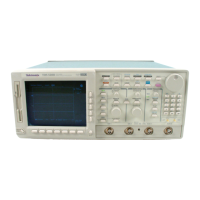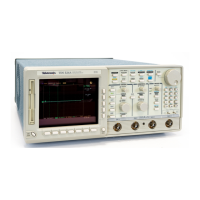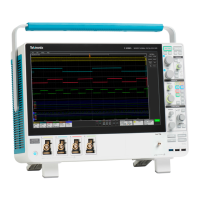Operating
Instructions—
5103N
Vertical Display Mode
Display On. To
display a signal,
the Display button of
the applicable
vertical plug-in unit must be
pushed
in to
activate the unit.
If two plug-ins are installed in the vertical
compartments and
only the
signal from one
of
the units
is
wanted, set the
Display
switch of the unwanted unit to
Off
(button out).
If
neither plug-in is activated, the signal
from
the
left
unit
will be
displayed. Both plug-ins can be acti-
vated
for multi-trace
displays.
Alternate
Mode.
The
alternate
position
of the time-base
unit
Display
switch
produces a
display which alternates be-
tween activated
plug-ins and
amplifier channels with each
sweep
of
the CRT.
The
switching sequence
is described
under Display
Switching
Logic in
this section. Although the
Alternate mode
can be used at
all sweep rates,
the
Chop
mode
provides a
more
satisfactory display at
sweep rates
from about
one
millisecond/division to
five
seconds/
division. At
these
slower sweep
rates, alternate-mode
switching becomes
difficult to
view.
Chopped Mode. The Chop position of the
time-base
unit Display switch produces
a
display which
is
electronically switched between channels
at a 200-kilohertz
rate. The switching sequence has been
discussed earlier.
In
general, the Chop mode provides the
best display
at
sweep
rates slower
than about one millisecond/division or
when-
ever dual-trace, single-shot phenomena
are to be displayed.
At
faster
sweep rates, the chopped switching
becomes
apparent
and may
interfere
with the display.
Dual-Sweep Displays.
When
a
dual-sweep time-base unit
is operated in the horizontal compartment, the alternate
and chopped time-shared
switching for either
the A or
B
sweep
is
identical to that
for
a single time-base unit. How-
ever, if
both
the
A
and
B
sweeps
are operating, the
5103N
operates in the independent
pairs
mode.
Under
this condi-
tion, the left vertical unit is
always
displayed at the
sweep
rate of the
A
time base and the right vertical unit
is dis-
played
at the
sweep rate
of
the
B
time base
(non-delayed
sweep
only). This
results in two displays that have com-
pletely
independent
vertical deflection and
chopped or
alternate sweep switching.
Dual-Beam Displays. When
a dual-beam display
module
is
operated with
the 5103N, the
switching
sequence
is
altered
slightly.
Between-channel
switching
occurs; how-
ever, switching
between
plug-ins is
not necessary
and does
not
occur. Also,
the
left
vertical
unit is always
displayed
by
the
upper
CRT beam and the right
vertical
unit is displayed
by the lower
CRT beam.
X-Y
Operation
In some
applications, it is desirable
to display
one signal
versus another
(X-Y) rather than
against an internal
sweep.
The
flexibility of
the plug-in units
available for
use with the
5103N
provides
a means
for
applying
a signal
to
the hori-
zontal
deflection
system
for
this type of
display. Some of
the
5B-series time-base
units can
be operated
as
amplifiers
in addition
to their normal
use
as
time-base
generators, or
an
amplifier
unit can be installed
in the horizontal
compart-
ment.
The latter
method
provides the
best X-Y
display,
particularly
if
two identical
amplifier
units are
used, since
both
the X and Y
input
systems will
have the
same capa-
bilities
and
characteristics.
In either
case, the mainframe
bandwidth
and
sensitivity are
equal
and inherent
phase shift
is adjustable
to 0 degrees in the
display
module. For
further
information
on obtaining
X-Y displays,
see
the plug-in
unit
manuals.
Raster
Display
A raster-type
display can be used
to
effectively
increase
the apparent sweep
length. For this
type
of
display, the
trace
is deflected both vertically
and horizontally
by
saw-
tooth signals, and is accomplished
by installing
a
5B-series
time-base
unit in one
of
the vertical
compartments as well
as one in the horizontal
compartment. Normally, the
unit
in the vertical
compartment should
be set to
a
slower sweep
rate
than
the one in the horizontal
compartment; the num-
ber of
horizontal
traces in the raster
depends upon the ratio
between
the two sweep
rates. Information
can be displayed
on the raster
using the Ext Intensity Input to provide
intensity
modulation of the
display. This type
of raster
display could
be used to provide
a
television-type display.
Complete information
on
operation
using the Z-axis feature
is
given in the operating instructions
section
of the display
module manuals.
BASIC
OSCILLOSCOPE
APPLICATIONS
General
The
5100-Series
Oscilloscope
and
its
associated
plug-in
units
provide
a very
flexible
measurement
system.
The
capabilities
of
the
overall
system
depend
mainly
upon the
plug-ins
that are
chosen for
use with
this
instrument.
The
following
information
describes
the
procedures
and
tech-
niques
for
making
basic
measurements.
These
applications
are not
described
in
detail,
since
each
application
must
be
adapted
to the
requirements
of the
individual
measurement.
Specific
applications
for
the
individual
plug-in
units are
described
in the
manuals for
those
units.
The overall
system
can also
be
used
for
many
applications
which
are
not
described
in
detail
either in
this
manual
or
in the
manuals
for
the
individual
plug-in
units.
Contact
your local
Tek-
tronix
Field
Office
or
representative
in making
specific
measurements
with
this instrument.

